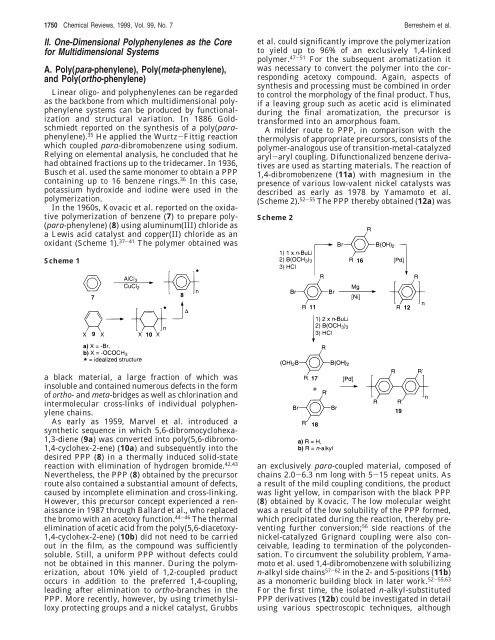Polyphenylene Nanostructures - Cluster for Molecular Chemistry
Polyphenylene Nanostructures - Cluster for Molecular Chemistry
Polyphenylene Nanostructures - Cluster for Molecular Chemistry
You also want an ePaper? Increase the reach of your titles
YUMPU automatically turns print PDFs into web optimized ePapers that Google loves.
1750 Chemical Reviews, 1999, Vol. 99, No. 7 Berresheim et al.<br />
II. One-Dimensional <strong>Polyphenylene</strong>s as the Core<br />
<strong>for</strong> Multidimensional Systems<br />
A. Poly(para-phenylene), Poly(meta-phenylene),<br />
and Poly(ortho-phenylene)<br />
Linear oligo- and polyphenylenes can be regarded<br />
as the backbone from which multidimensional polyphenylene<br />
systems can be produced by functionalization<br />
and structural variation. In 1886 Goldschmiedt<br />
reported on the synthesis of a poly(paraphenylene).<br />
35 He applied the Wurtz-Fittig reaction<br />
which coupled para-dibromobenzene using sodium.<br />
Relying on elemental analysis, he concluded that he<br />
had obtained fractions up to the tridecamer. In 1936,<br />
Busch et al. used the same monomer to obtain a PPP<br />
containing up to 16 benzene rings. 36 In this case,<br />
potassium hydroxide and iodine were used in the<br />
polymerization.<br />
In the 1960s, Kovacic et al. reported on the oxidative<br />
polymerization of benzene (7) to prepare poly-<br />
(para-phenylene) (8) using aluminum(III) chloride as<br />
a Lewis acid catalyst and copper(II) chloride as an<br />
oxidant (Scheme 1). 37-41 The polymer obtained was<br />
Scheme 1<br />
a black material, a large fraction of which was<br />
insoluble and contained numerous defects in the <strong>for</strong>m<br />
of ortho- and meta-bridges as well as chlorination and<br />
intermolecular cross-links of individual polyphenylene<br />
chains.<br />
As early as 1959, Marvel et al. introduced a<br />
synthetic sequence in which 5,6-dibromocyclohexa-<br />
1,3-diene (9a) was converted into poly(5,6-dibromo-<br />
1,4-cyclohex-2-ene) (10a) and subsequently into the<br />
desired PPP (8) in a thermally induced solid-state<br />
reaction with elimination of hydrogen bromide. 42,43<br />
Nevertheless, the PPP (8) obtained by the precursor<br />
route also contained a substantial amount of defects,<br />
caused by incomplete elimination and cross-linking.<br />
However, this precursor concept experienced a renaissance<br />
in 1987 through Ballard et al., who replaced<br />
the bromo with an acetoxy function. 44-46 The thermal<br />
elimination of acetic acid from the poly(5,6-diacetoxy-<br />
1,4-cyclohex-2-ene) (10b) did not need to be carried<br />
out in the film, as the compound was sufficiently<br />
soluble. Still, a uni<strong>for</strong>m PPP without defects could<br />
not be obtained in this manner. During the polymerization,<br />
about 10% yield of 1,2-coupled product<br />
occurs in addition to the preferred 1,4-coupling,<br />
leading after elimination to ortho-branches in the<br />
PPP. More recently, however, by using trimethylsiloxy<br />
protecting groups and a nickel catalyst, Grubbs<br />
et al. could significantly improve the polymerization<br />
to yield up to 96% of an exclusively 1,4-linked<br />
polymer. 47-51 For the subsequent aromatization it<br />
was necessary to convert the polymer into the corresponding<br />
acetoxy compound. Again, aspects of<br />
synthesis and processing must be combined in order<br />
to control the morphology of the final product. Thus,<br />
if a leaving group such as acetic acid is eliminated<br />
during the final aromatization, the precursor is<br />
trans<strong>for</strong>med into an amorphous foam.<br />
A milder route to PPP, in comparison with the<br />
thermolysis of appropriate precursors, consists of the<br />
polymer-analogous use of transition-metal-catalyzed<br />
aryl-aryl coupling. Difunctionalized benzene derivatives<br />
are used as starting materials. The reaction of<br />
1,4-dibromobenzene (11a) with magnesium in the<br />
presence of various low-valent nickel catalysts was<br />
described as early as 1978 by Yamamoto et al.<br />
(Scheme 2). 52-55 The PPP thereby obtained (12a) was<br />
Scheme 2<br />
an exclusively para-coupled material, composed of<br />
chains 2.0-6.3 nm long with 5-15 repeat units. As<br />
a result of the mild coupling conditions, the product<br />
was light yellow, in comparison with the black PPP<br />
(8) obtained by Kovacic. The low molecular weight<br />
was a result of the low solubility of the PPP <strong>for</strong>med,<br />
which precipitated during the reaction, thereby preventing<br />
further conversion; 56 side reactions of the<br />
nickel-catalyzed Grignard coupling were also conceivable,<br />
leading to termination of the polycondensation.<br />
To circumvent the solubility problem, Yamamoto<br />
et al. used 1,4-dibromobenzene with solubilizing<br />
n-alkyl side chains 57-62 in the 2- and 5-positions (11b)<br />
as a monomeric building block in later work. 52-55,63<br />
For the first time, the isolated n-alkyl-substituted<br />
PPP derivatives (12b) could be investigated in detail<br />
using various spectroscopic techniques, although

















